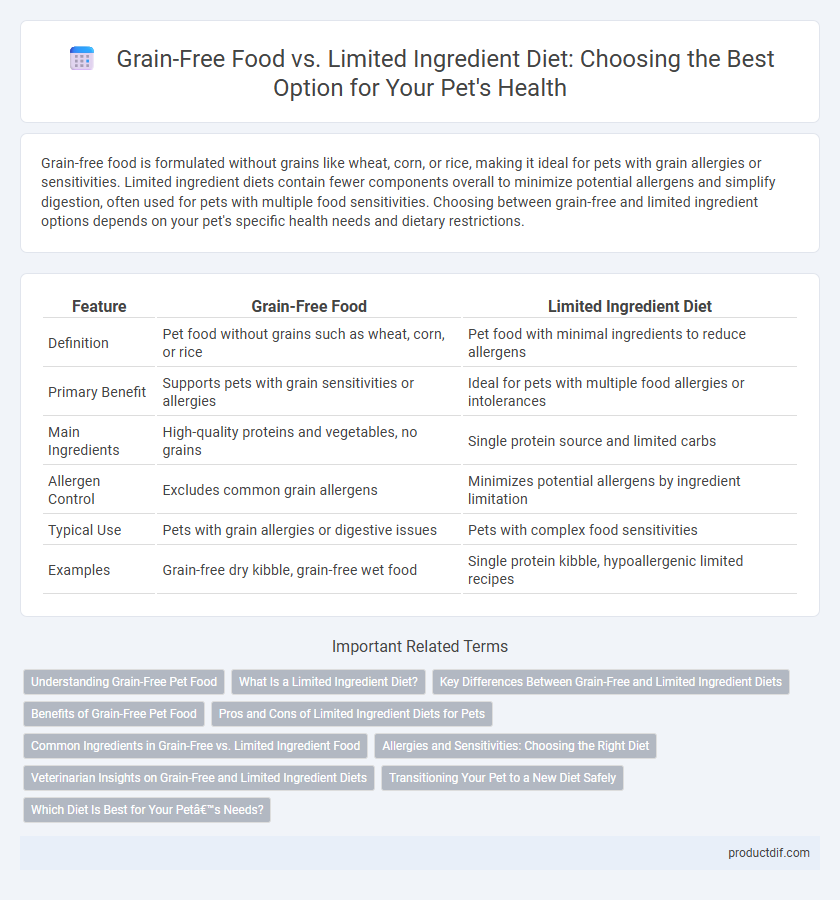Grain-free food is formulated without grains like wheat, corn, or rice, making it ideal for pets with grain allergies or sensitivities. Limited ingredient diets contain fewer components overall to minimize potential allergens and simplify digestion, often used for pets with multiple food sensitivities. Choosing between grain-free and limited ingredient options depends on your pet's specific health needs and dietary restrictions.
Table of Comparison
| Feature | Grain-Free Food | Limited Ingredient Diet |
|---|---|---|
| Definition | Pet food without grains such as wheat, corn, or rice | Pet food with minimal ingredients to reduce allergens |
| Primary Benefit | Supports pets with grain sensitivities or allergies | Ideal for pets with multiple food allergies or intolerances |
| Main Ingredients | High-quality proteins and vegetables, no grains | Single protein source and limited carbs |
| Allergen Control | Excludes common grain allergens | Minimizes potential allergens by ingredient limitation |
| Typical Use | Pets with grain allergies or digestive issues | Pets with complex food sensitivities |
| Examples | Grain-free dry kibble, grain-free wet food | Single protein kibble, hypoallergenic limited recipes |
Understanding Grain-Free Pet Food
Grain-free pet food eliminates grains such as wheat, corn, and rice to reduce allergens and improve digestion, making it ideal for pets with grain sensitivities or allergies. Limited ingredient diets focus on minimizing the number of ingredients included, often using novel proteins and carbohydrates to reduce the risk of food intolerances. Understanding the differences helps pet owners select the appropriate formula to support their pet's health and nutritional needs.
What Is a Limited Ingredient Diet?
A limited ingredient diet (LID) for pets features a simplified formula with a minimal number of protein and carbohydrate sources to reduce the risk of food allergies and sensitivities. This diet often includes one novel protein such as duck or venison, paired with a single carbohydrate like sweet potato or peas, making it easier to identify and avoid specific allergens. Limited ingredient diets support pets with digestive issues or food intolerances by minimizing exposure to common allergens found in traditional pet foods.
Key Differences Between Grain-Free and Limited Ingredient Diets
Grain-free pet food excludes all grains such as wheat, corn, and rice, catering primarily to pets with grain sensitivities or allergies, while limited ingredient diets reduce the number of components to minimize exposure to potential allergens and simplify digestion. Grain-free diets often contain alternative carbohydrates like potatoes or peas, whereas limited ingredient diets emphasize a single protein source combined with minimal, easily digestible ingredients. Both diets serve specialized nutritional needs, but grain-free focuses on grain elimination, and limited ingredient prioritizes ingredient simplicity and allergen reduction.
Benefits of Grain-Free Pet Food
Grain-free pet food benefits pets with grain allergies or sensitivities by reducing digestive issues such as bloating and diarrhea. This diet promotes better nutrient absorption and supports healthier skin and coat due to the absence of common grain fillers. Many grain-free formulas incorporate high-quality proteins and alternative carbohydrate sources like sweet potatoes or peas, enhancing overall pet health and energy levels.
Pros and Cons of Limited Ingredient Diets for Pets
Limited ingredient diets (LIDs) for pets reduce the risk of food allergies and sensitivities by minimizing exposure to potential allergens, making them ideal for pets with digestive issues or food intolerances. However, LIDs may lack variety and certain essential nutrients if not properly formulated, potentially leading to nutritional imbalances over time. Consulting a veterinarian ensures the chosen LID meets the pet's specific health needs while maintaining a balanced diet.
Common Ingredients in Grain-Free vs. Limited Ingredient Food
Grain-free pet food commonly features protein sources such as chicken, lamb, or fish paired with alternative carbohydrates like sweet potatoes, peas, or lentils, while limited ingredient diets prioritize a reduced number of components to minimize allergens and intolerances. Both grain-free and limited ingredient diets often exclude traditional grains like wheat, corn, and soy, but limited ingredient formulas focus more on novel or single protein and carbohydrate sources to prevent adverse reactions. Understanding these ingredient distinctions helps pet owners select the best nutritionally balanced option for pets with food sensitivities or allergies.
Allergies and Sensitivities: Choosing the Right Diet
Grain-free pet food eliminates common allergens like wheat, corn, and soy, making it suitable for pets with grain sensitivities. Limited ingredient diets reduce the number of components to minimize exposure to potential allergens, ideal for pets with multiple food sensitivities or allergies. Selecting between grain-free and limited ingredient options depends on the pet's specific allergic reactions and the advice of a veterinarian for optimal dietary management.
Veterinarian Insights on Grain-Free and Limited Ingredient Diets
Veterinarians emphasize that grain-free diets eliminate common allergens like wheat and corn, benefiting pets with grain sensitivities but may lack essential nutrients found in whole grains. Limited ingredient diets focus on reducing the number of components to identify and minimize allergens, making them ideal for pets with food allergies or intolerances. Careful formulation by vets ensures these diets meet nutritional needs while managing pets' specific health conditions.
Transitioning Your Pet to a New Diet Safely
Transitioning your pet to a grain-free food or a limited ingredient diet requires a gradual introduction over 7 to 10 days to prevent digestive upset and ensure optimal nutrient absorption. Start by mixing 25% of the new diet with 75% of the current food, progressively increasing the new food ratio until the transition is complete. Monitoring your pet's stool quality and overall behavior during this period helps identify any adverse reactions early.
Which Diet Is Best for Your Pet’s Needs?
Choosing between grain-free food and a limited ingredient diet depends on your pet's specific health requirements and dietary sensitivities. Grain-free diets eliminate common grains like wheat, corn, and rice to reduce allergies and improve digestion, while limited ingredient diets focus on minimizing the number of components to isolate allergens or intolerances. Consulting a veterinarian ensures the optimal diet tailored to your pet's digestive health, allergies, and nutritional needs.
Grain-Free Food vs Limited Ingredient Diet Infographic

 productdif.com
productdif.com